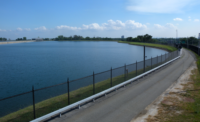When Indianapolis Mayor Greg Ballard came into office in 2008, he inherited a wastewater treatment and sewer system that was averaging 7.8 billion gallons of overflow each year, according to federal officials. At the time, it was not unusual for as little as one-quarter to a half inch of rainfall to fill the combined sewers to capacity and flood raw sewage into local rivers and streams. Ballard also inherited a two-year-old consent decree with the U.S. Dept. of Justice to bring the city in compliance with the Clean Water Act as well as a project to expand its wastewater treatment systems that were running over budget by an estimated $300 million and months behind schedule, due in part to complex design approaches.
Although the city had built separate storm and sanitary sewers in newer neighborhoods, development over the years had lagged behind in older, densely populated areas of the city. As far back as the early 1990s, combined sewer overflows (CSOs) were a problem for local streams during extended wet weather.
The remediation plan was originally estimated to cost $1.73 billion, but costs quickly escalated to $1.975 billion, mainly because of cost overruns on one of the wastewater treatment plants. This kind of status quo was not acceptable to a mayor who had a vision of sustainable and affordable infrastructure for a city of more than 800,000 residents, says Mark Jacob, vice president with Columbus, Ohio-based DLZ, a program manager for the consent decree.
The mayor brought in industry veteran David Sherman, a former president of United Water, to head up his Public Works Dept. and take a hard look at the program. “[Ballard] wanted to make sure [Indianapolis] was a clean-water city, that we took care of the overflows, and he was willing to make the investment to value-engineer the whole program,” says Sherman.
What they came up with is a mix of value engineering and innovative green approaches to absorbing water runoff before it reaches the upgraded wastewater treatment plants. The re-engineered approach has cut more than $740 million off the city’s 20-year consent-decree program, officials say. In December, a federal court approved modifications to the city’s 2006 consent decree, a highly unusual step, according to the Justice Dept.
Now, the mayor and other city groups are touting Indianapolis as a model for how to use value engineering to create cost savings and solutions that are better for the environment and can shave off millions from the compliance plans.
Sherman worked with the existing engineering team, mainly local firms such as Indianapolis-based R.W. Armstrong. To review the plan, DLZ brought in firms such as Overland Park, Kan.-based Black & Veatch and Broomfield, Colo.-based MWH, both of which have experience working with consent decrees. “It was a collaborative effort—we had an open-door policy,” Sherman says. The plan involved two main approaches: expanding the sewer system to catch more wastewater and changing the design of the sewage plant’s secondary-treatment scheme. In addition to the engineering approaches, a separate green system, deployed to absorb more of the water before it’s treated, could become a blueprint for other cities struggling to comply with the Clean Water Act.
Deep Rock Tunnel Connector Changes the Equation
The original consent decree required the city to construct 31 combined sewer control measures, including a 24-million-gallon-capacity shallow interceptor sewer, in order to reduce the city’s overflow average of 7.8 billion gallons to a less offending 642 million gallons per year, according to the Dept. of Justice.
The design and public-works teams decided to shape a new plan. They replaced a 12-ft-dia shallow interceptor sewer—mainly a conveyance tunnel—with a 54-million-gallon, seven-mile-long Deep Rock Tunnel Connector that will extend between the city’s two wastewater treatment plants, which are typically overwhelmed during storm events.

The Deep Rock Tunnel Connector will be wider than the earlier shallow interceptor sewer—with an internal diameter of 18 ft, compared to 12 ft. The tunnel will act as a kind of holding area where multiple sewer overflows can be stored.
Because the new tunnel is wider and deeper, it is expected to capture—and capture earlier—an additional one billion gallons of raw sewage through 2021, compared to the original design, according to DPW.
DLZ’s Jacob says the new tunnel eliminates the need for one of the pumping stations in the original plan that would have cost approximately $30 million. By deploying the Deep Rock Tunnel Connector plan, the city is able to avoid the extra costs of rights-of-way issues with utilities as well as potential groundwater contamination, Jacob says. “It’s a much less risky venture, and it still provides for us to meet the performance criteria [of the consent decree] and actually store a lot of the flows,” he says.
The $257-million Deep Rock Tunnel Connector portion of the overall project is being designed by Los Angeles-based AECOM. Officials expect it to go out for bid in spring 2011, well ahead of the Dec. 31 consent-decree deadline, Jacob says. The project is expected to be completed in 2017.
Although the Deep Rock Tunnel will require a slightly higher up-front investment than the shallow interceptor plan—which was estimated to cost $151 million—Sherman says, “we knew ultimately we wouldn’t need as much volume out there in the field” for overflows because of the Deep Rock Tunnel’s ability to hold more water, which would save money down the road. Plus, the approach helps modulate another key portion of the compliance plan: how much water the secondary-treatment design could handle.
Primary Changes in Secondary-Treatment Design
The city of Indianapolis and the engineering team re-evaluated the design at the Belmont advanced wastewater treatment plant expansion, which is located just south of the city. The newer approaches are expected to nearly double the secondary-treatment capacity to 300 million gallons per day.
After evaluating the plan and looking at a $90 million estimate that had more than doubled, the team opted to switch from a trickling filter system for secondary treatment to an activated sludge system.
According to Robert Bolden, vice president at Kansas City, Mo.-based HNTB, the designer on the project,...








Post a comment to this article
Report Abusive Comment